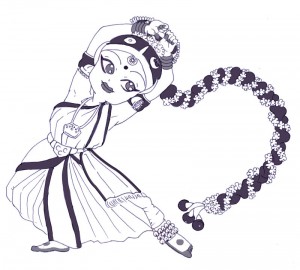
Anupama Mohan, a famous Kuchipudi dancer, has filed a Writ Petition in the Kerala High Court alleging copyright infringement by the state government. Allegedly, the Government has leaked video recordings of dance performances which took place in a State-sponsored inter-school Competition and profited from its distribution (read Livelaw’s coverage of the story here). In this two part post I discuss the several interesting legal issues that this Writ Petition throws up. While Part I discusses copyright, Part II will discuss Performers’ Rights.
The Kerala School Youth Festival is an annual event organised by the Kerala state government that consists of students competing in art and literary competitions. The petitioner is a Kuchipudi artiste who also teaches the dance form to students who ultimately go on to perform at the Youth Festival. According to the petitioner, the videos of the performances were recorded by authorized third parties at the venue “to avoid complaints and decide on appeals” that arise from the judges’ decisions in the competition. Further, the original sound used in the performance is handed over to the organisers. It is alleged that these video recordings along with the audio are being sold by the organisers of the show over the internet without the consent of the Copyright holders (whom the petitioner alleges is the petitioner as well as the performers of the dance). The petition alleges that as the authors and First Owners of the works in the video CDs, they have the exclusive right to issue copies of the performance.
What struck me first was that the Petition alleges that the distribution of the video is a violation of the copyright of the petitioner and the children who performed the dance. The Petition does not explain under what category the performance is copyrightable. The question this raises is whether there copyright subsists at all in a video of a dance that is recorded by a third person; and if so, to whom? In answering these questions, one wades into the murky areas of copyright law in India- that of copyright in choreography and dance forms, and an issue that should have been raised in the petition but wasn’t- that of Performers Rights (which I will discuss in Part II of this post).
Let’s first address the issue of whether a particular dance performance is copyrightable. S.2(h) of the Copyright Act defines “dramatic work” as “.. any piece for recitation, choreographic work or entertainment in dumb show, the scenic arrangement or acting form of which is fixed in writing or otherwise but does not include a cinematograph film”. We have blogged before on SpicyIP regarding the inadequacy of this definition, especially because the import of “or otherwise” is broad as well as unclear. In this case, we do not know of the dance performance was fixed in writing. We do know that it was ‘fixed’ by virtue of a video being taken of the performance, with the consent of the performers, by a third party (as recording the performances was ostensibly part of the rules of the Competition, whether the consent was free is another issue altogether). However, Cinematograph Film is defined in S.2(f) as “…any work of visual recording on any medium produced through a process from which a moving image may be produced by any means..”. Is the definition of “cinematograph film” in the Copyright Act is broad enough to encompass any video?
The exclusion of cinematograph film as a form of fixation appears unique to India. In the US and the UK, choreography can be fixed through any medium, including making a video. There is no logical reason why a dramatic work, such as a choreographed dance, cannot be ‘fixed’ on to a home video (for example) in order to be copyrightable. Perhaps the legislative intent behind the phrasing of S.2(h) is to protect producers of cinematograph films from being challenged by the authors of the underlying dramatic works (such as scriptwriters) in the film. However, when read with the broad definition of “cinematograph film”, the protection of copyright over dramatic works appears to be put in serious jeopardy. After all, it is very difficult to “fix” a dance choreograph in any other medium but video.
Finally, if fixation on to a cinematograph film excludes the performance from being copyrightable as a dramatic work, we need to examine if the copyright subsists in the cinematograph film itself. If so, the author of the film is the ‘producer’. According to the Copyright Act, a producer is a “person who takes the initiative and responsibility for making the work”. This definition brings with it a host of other questions regarding whom the producer is- if the organizers of the dance competition took the initiative to record the performance for judging purposes, does it make them the producer?
Hence, clearly, the law surrounding copyright in choreographed works is murky and unsettled. The Copyright Act ostensibly provides more straightforward protection to dancers through the provisions for Performer’s Rights. While the WP does not discuss these rights, I will examine whether these rights can be invoked in this case in Part II of this post.

The definition of “dramatic” work does not exclude anything from copyright. It requires that a dramatic work should be fixed in some way (not excluding in a cinematograph film). Further, it clarifies that a cinematograph film is not a dramatic work per se. That does not mean a film cannot visually record a dramatic work–in fact that it what it usually does; the last part of the definition is only clarificatory and in fact restates the obvious, maintaining the distinction between the underlying work and the film in which it may be fixed.